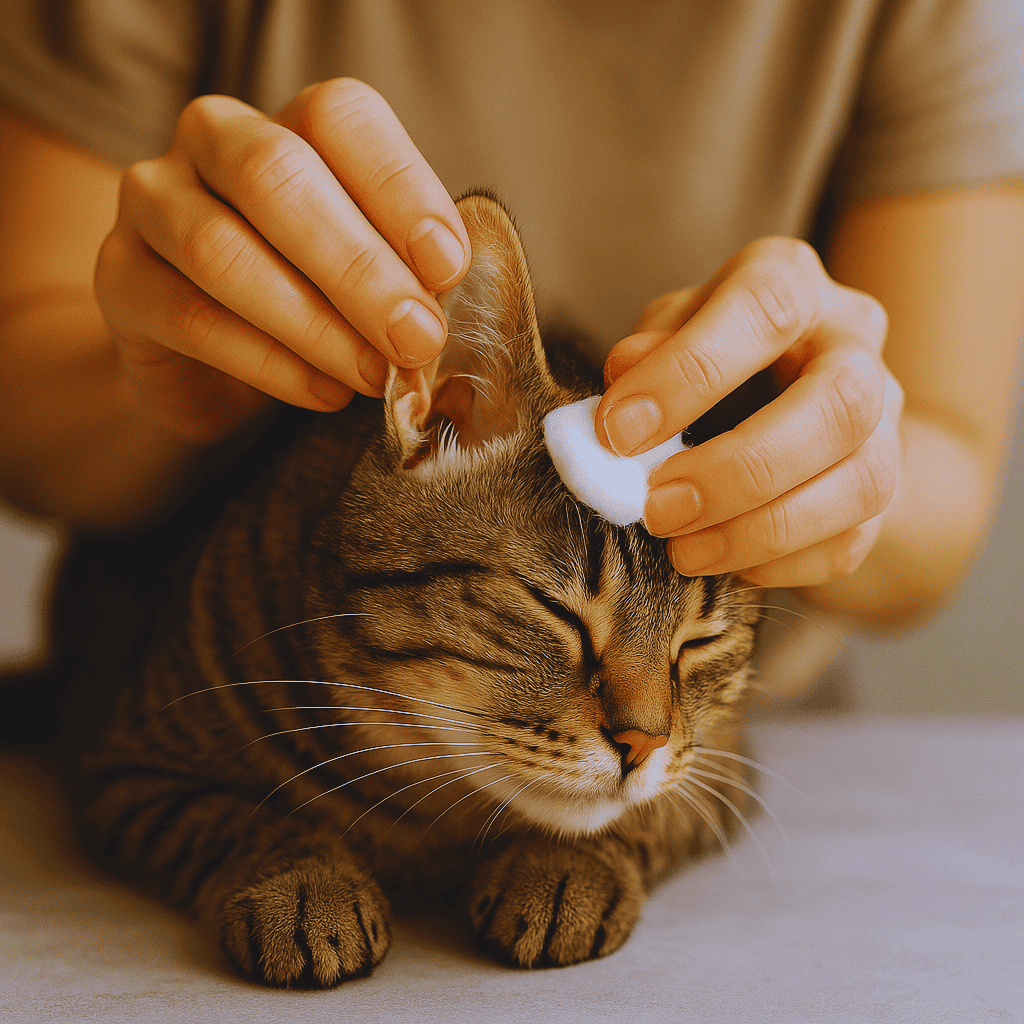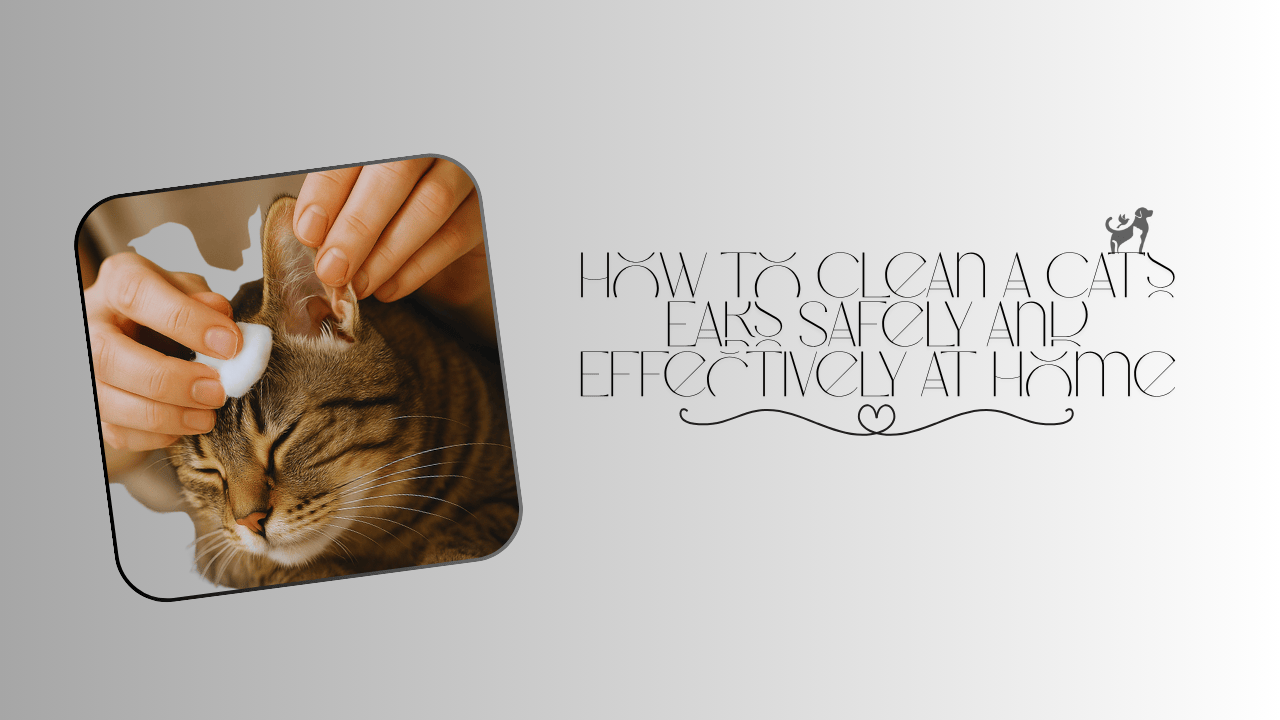Keeping your cat’s ears clean is an essential (but often overlooked) part of feline care. Whether you’re a new cat parent or caring for a breed prone to ear issues, this guide will show you exactly how to do it gently, safely, and effectively.

Why Cleaning Your Cat’s Ears Matters
While cats are known for being excellent groomers, their ears are one area they can’t fully clean themselves. Dirt, wax buildup, mites, or even yeast infections can silently develop in the ear canal.
Left unchecked, these issues can lead to:
- Itchiness and discomfort
- Foul odor or discharge
- Pain, head shaking, or even ear infections
Cleaning your cat’s ears helps prevent infections and allows you to catch early signs of more serious health problems.
How Often Should You Clean a Cat’s Ears?
Most cats don’t need frequent ear cleanings. For healthy indoor cats, a monthly check and occasional cleaning is usually enough.
However, certain breeds like Scottish Folds are more prone to ear issues due to their unique folded ears. Learn more in our full guide:
Scottish Fold Health Issues
Other situations that may require more regular cleaning:
- Cats with allergies
- Outdoor cats exposed to dirt or mites
- Senior cats with reduced self-grooming
Signs Your Cat Might Need an Ear Cleaning
Before you grab the cotton balls, check if your cat is showing these signs:
- Frequent head shaking or pawing at ears
- Redness or dark discharge in ear canal
- Strong odor coming from the ears
- Visible wax buildup
- Sensitivity when you touch the ear
If there’s pus, swelling, or your cat shows signs of pain, stop and consult your vet first. Cleaning infected ears can cause more harm.
What You’ll Need
Here’s what you’ll need for a safe and gentle cleaning session:
- Cat-safe ear cleaner (Never use hydrogen peroxide or alcohol)
→ Recommended: PetMD® Ear Cleaner for Cats - Cotton balls or gauze pads
- Towel (to wrap your cat if needed)
- Treats to reward calm behavior
- Optional: A friend to gently hold the cat
Pro tip: Never use cotton swabs (Q-tips) inside the ear canal — they can push debris deeper or damage the ear.
Step-by-Step: How to Clean a Cat’s Ears
1. Find a Calm, Quiet Spot
Choose a place where your cat feels secure — like a bathroom or familiar room. You may want to wrap your cat in a towel burrito-style to reduce squirming.
2. Gently Examine the Ear
Hold the tip of your cat’s ear and gently fold it back. Look for wax, debris, or irritation.
3. Apply Ear Cleaner
Squeeze a few drops of the cleaner into the ear canal. Don’t insert anything deep inside. Let the solution fill the base.
You might hear a squelching sound — that’s normal.
4. Massage the Base of the Ear
Massage for 15–30 seconds to help break up wax and debris.
5. Let Your Cat Shake It Out
Your cat will likely shake their head afterward. That’s good — it helps loosen dirt.
6. Wipe the Outer Ear
Use a cotton ball or gauze to gently wipe out the debris. Don’t push deep.
7. Reward Your Cat
Praise your cat and offer treats to build a positive experience. The goal is to make ear cleaning routine and stress-free.
Common Mistakes to Avoid
- ❌ Using Q-tips — Can damage the ear or push wax further in
- ❌ Over-cleaning — May irritate the ear canal
- ❌ Using human ear products — Not safe for cats
- ❌ Cleaning infected ears without a vet’s advice
- ❌ Skipping reward/treats — Makes the next time harder!
When to See a Veterinarian
If you notice any of the following, skip DIY and book a vet visit:
- Bloody or yellow discharge
- Swelling or redness inside the ear
- Intense scratching or constant head tilting
- Loss of balance
- Bad odor despite cleaning
Your vet may need to test for mites, yeast, or bacterial infections and prescribe medication.
FAQ: Cat Ear Cleaning
Q1: Can I clean my cat’s ears with baby wipes?
No. Baby wipes may contain perfumes or chemicals unsafe for cats. Use cat-specific ear cleaning solutions and cotton pads.
Q2: What’s the black stuff in my cat’s ears?
It could be earwax — but if it looks like coffee grounds, it may be ear mites. Get it checked by your vet.
Q3: How often should I clean a kitten’s ears?
Only when dirty — kittens are sensitive. Ask your vet first before cleaning young cats.
Q4: Can I use olive oil to clean my cat’s ears?
Not recommended. Some home remedies are outdated and may trap more debris. Stick to vet-approved cleaners.
Q5: My cat hates ear cleaning. What do I do?
Use calming treats, take breaks, and never force it. You can also ask your vet to show you a safe technique.
Final Thoughts
Cleaning your cat’s ears doesn’t have to be a struggle. With the right tools, gentle handling, and a bit of patience, you can make it a quick, stress-free routine that protects your cat from discomfort and infection.
Want more helpful pet care guides? Explore more on Fluffze.com — your trusted source for dog and cat wellness, training, and lifestyle tips.
Call to Action
If this helped you or your kitty, share this article with other cat parents!
Want more grooming tips? Check out our upcoming post on how to brush your cat’s teeth.
Author Information
Written by Shawn, pet lover & contributor at Fluffze
Lifelong cat dad and fan of simple, stress-free pet care.
Related Cat Care You Shouldn’t Miss
Homemade Pet Safe Cleaning Solutions: A Healthier Way
Sphynx Cat Health Issues: A Complete Guide to Prevent Common Risks
How to Brush a Cat’s Teeth Without Stressing Your Pet
Smart Cat Dental Care at Home: Keep Your Cat’s Smile Healthy





